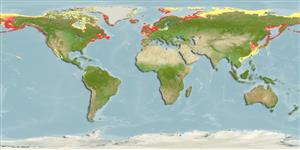Bivalvia |
Myida |
Myidae
Environment: milieu / climate zone / εύρος βάθους / distribution range
Οικολογία
; εύρος βάθους 2 - 100 m (Αναφ. 83435). Temperate; 84°N - 34°N, 180°W - 180°E
Arctic, Northern Atlantic and Northern Pacific.
Length at first maturity / Μέγεθος / Weight / Age
Γεννητική Ωρίμανση: Lm ? range ? - ? cm Max length : 8.0 cm SHL αρσενικό/απροσδιόριστο; (Αναφ. 95344)
Maximum depth from Ref. 95344. Suspension feeder; burrows at considerable depths in mixed sand, sandy mud, or gravel substrata from the lower shore to about 70 m (Ref. 3477). Main food is based on another species of the same Genus; to be replaced with a better reference (Ref. 95774).
Life cycle and mating behavior
Γεννητική Ωρίμανση | Αναπαραγωγή | Γεννοβολία | Eggs | Γονιμότητα | Larvae
Members of the class Bivalvia are mostly gonochoric, some are protandric hermaphrodites. Life cycle: Embryos develop into free-swimming trocophore larvae, succeeded by the bivalve veliger, resembling a miniature clam.
Piepenburg, D., N.V. Chernova, C.F. von Dorrien, J. Gutt, A.V. Neyelov, E. Rachor, L. Saldanha and M.K. Schmid 1996 Megabenthic communities in the waters around Svalbard. Polar Biol. 16:431-446. (Αναφ. 2952)
IUCN Red List Status
(Αναφ. 130435: Version 2025-1)
CITES status (Αναφ. 108899)
Not Evaluated
Not Evaluated
Threat to humans
Human uses
| FishSource |
Εργαλεία
Περισσότερες πληροφορίες
Τροφική ΟικολογίαFood items (preys)Σύσταση δίαιταςΚατανάλωση τροφήςΘηρευτές Life cycleΑναπαραγωγήΓεννητική ΩρίμανσηΓονιμότηταΓεννοβολίαEggsEgg developmentLarvae PhysiologyΚατανάλωση οξυγόνου
Human RelatedStamps, coins, misc.
Διαδικτυακές πηγές
Estimates based on models
Preferred temperature
(Ref.
115969): 0.6 - 13.3, mean 5 (based on 2454 cells).
Ελαστικότητα
Χαμηλό, ελάχιστος χρόνος για διπλασιασμό πληθυσμού 4,5 - 14 έτη (K=0.08).
Fishing Vulnerability
Moderate to high vulnerability (46 of 100).
Price category
Unknown.
